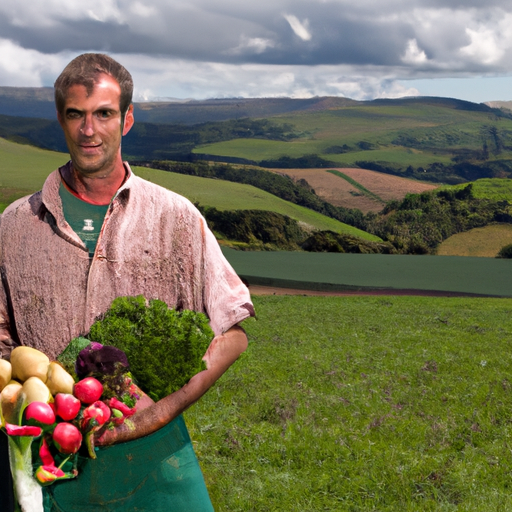What’s the Deal with Farm-to-Table?
So, you’ve heard about this new trend called “farm-to-table,” and you’re wondering what it’s all about. In short, it’s exactly what it sounds like: eating food that comes straight from the farm to your table. It’s about eating locally-sourced, fresh, and often organic food that’s in season.
But why should you care? What makes farm-to-table so special? Well, let me tell you, there are plenty of benefits to this way of eating. For one, you’ll be getting more nutrition since the food hasn’t traveled far and has been picked at the peak of freshness. Plus, by eating locally-sourced food, you’re reducing your environmental impact and supporting local farmers.
But how do you actually go about implementing farm-to-table eating? It’s easier than you might think. You can start by shopping at local farms and markets, joining a Community Supported Agriculture program, and researching restaurants that offer farm-to-table dishes.
Trust me, once you start incorporating farm-to-table eating into your life, you won’t want to go back to the old way. So, why not give it a try? Your taste buds and your health will thank you.
The Perks of Eating Farm-to-Table Food
Let’s dive into the advantages of incorporating more locally sourced, farm-fresh food into your life. Your body, your community, and the planet will thank you!

When you eat produce that is in season and comes from a nearby farm, it is often picked at its peak ripeness. This means that it has more vitamins, minerals, and antioxidants than fruits and veggies that are picked early and ripen during transport. Plus, farmers use less preservatives and other toxins on crops that don’t have to travel thousands of miles to reach your plate.
Leave a Lighter Environmental Footprint
By buying food from local farms, you’re reducing the number of miles food has to travel to reach your plate. This can lower your carbon footprint and make a positive impact on climate change. Additionally, local farmers typically use fewer pesticides and other chemicals, which is better for the land, water, and wildlife in your area.
Support Local Agriculture and Your Community
When you buy food from local farms, you’re contributing to the economy of your community. You’re helping to support the livelihoods of your neighbors and keeping your money in the area. This can help create a more vibrant and sustainable community. Plus, you can often get to know your farmers and ask them about their growing practices, which can create connections and a sense of community.
Overall, adding more farm-to-table foods to your diet can bring about a wide range of benefits that positively affect your health, the environment, and your community. So, why not give it a try?
How to Make Farm-to-Table Eating a Reality
So you’ve decided to start eating healthier and more sustainably by incorporating farm-to-table foods into your diet. But where do you start? Here are some tips that have helped me:
Shop at Local Farms and Markets
One of the easiest ways to start eating farm-to-table is to buy your produce from local farms or farmers markets. Not only are the fruits and veggies fresher and tastier, but you’re also supporting local farmers and reducing your carbon footprint by reducing transportation emissions. Check out this article for more information on the benefits of local food.
Join a Community Supported Agriculture Program
If you’re really committed to eating farm-to-table, consider joining a Community Supported Agriculture (CSA) program. These programs allow you to buy a share of a local farm’s harvest, which is delivered to you weekly or bi-weekly. Not only do you get access to fresh, seasonal produce, but you’re also supporting the local farming community and getting to know the people who grow your food.
Research Restaurants that Offer Farm-to-Table Dishes
If you’re looking to eat out but still want to stick to your farm-to-table principles, research restaurants that offer local, seasonal dishes. Many chefs are now prioritizing fresh, sustainable ingredients, and are creating delicious menus that showcase the best of what’s available in their area. Use websites like Yelp or OpenTable to find restaurants that prioritize farm-to-table eating.
By following these tips, you’ll be on your way to a healthier, more sustainable, and more delicious way of eating. Happy eating!
My Thoughts on Farm-to-Table Eating
Overall, I think that farm-to-table eating is a fantastic way to incorporate healthy, fresh food into your diet while also supporting local farmers and reducing your environmental impact. By shopping at local farms and markets or joining a community supported agriculture program, you have access to some of the freshest and tastiest foods that you wouldn’t otherwise have been able to find. In addition to the benefits of the food itself, you also know that you’re supporting farmers in your community who work hard to provide you with high-quality ingredients.
The benefits of farm-to-table eating extend beyond the food itself; by reducing your reliance on mass-produced, processed foods, you’re also reducing your impact on the environment. Buying directly from local farms means less packaging, less transportation, and less waste. Plus, by eating food that’s in season and grown locally, you’re also reducing the amount of energy required to grow and transport food.
If you’re interested in incorporating more farm-to-table eating into your life, I recommend doing some research to find local farms and markets in your area. Many of these farms will offer CSA programs, which can be a great way to receive fresh, seasonal produce on a regular basis. You can also search for restaurants in your area that offer farm-to-table dishes, which can be a fun way to try new foods and support local businesses.
In conclusion, farm-to-table eating is an excellent way to prioritize healthy, fresh food while also supporting your community and reducing your environmental impact. By making a few small changes to your eating habits, you can create a more sustainable, enjoyable way of eating that supports your health and the health of the planet.